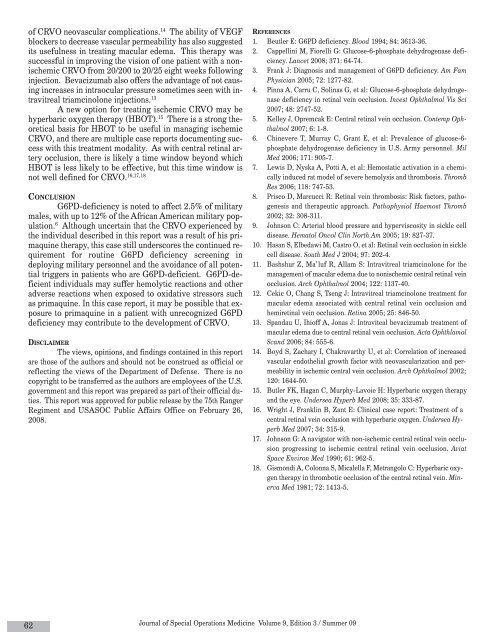Summer - United States Special Operations Command
Summer - United States Special Operations Command
Summer - United States Special Operations Command
You also want an ePaper? Increase the reach of your titles
YUMPU automatically turns print PDFs into web optimized ePapers that Google loves.
of CRVO neovascular complications. 14 The ability of VEGFblockers to decrease vascular permeability has also suggestedits usefulness in treating macular edema. This therapy wassuccessful in improving the vision of one patient with a nonischemicCRVO from 20/200 to 20/25 eight weeks followinginjection. Bevacizumab also offers the advantage of not causingincreases in intraocular pressure sometimes seen with intravitrealtriamcinolone injections. 13A new option for treating ischemic CRVO may behyperbaric oxygen therapy (HBOT). 15 There is a strong theoreticalbasis for HBOT to be useful in managing ischemicCRVO, and there are multiple case reports documenting successwith this treatment modality. As with central retinal arteryocclusion, there is likely a time window beyond whichHBOT is less likely to be effective, but this time window isnot well defined for CRVO. 16,17,18CONCLUSIONG6PD-deficiency is noted to affect 2.5% of militarymales, with up to 12% of the African American military population.6 Although uncertain that the CRVO experienced bythe individual described in this report was a result of his primaquinetherapy, this case still underscores the continued requirementfor routine G6PD deficiency screening indeploying military personnel and the avoidance of all potentialtriggers in patients who are G6PD-deficient. G6PD-deficientindividuals may suffer hemolytic reactions and otheradverse reactions when exposed to oxidative stressors suchas primaquine. In this case report, it may be possible that exposureto primaquine in a patient with unrecognized G6PDdeficiency may contribute to the development of CRVO.DISCLAIMERThe views, opinions, and findings contained in this reportare those of the authors and should not be construed as official orreflecting the views of the Department of Defense. There is nocopyright to be transferred as the authors are employees of the U.S.government and this report was prepared as part of their official duties.This report was approved for public release by the 75th RangerRegiment and USASOC Public Affairs Office on February 26,2008.REFERENCES1. Beutler E: G6PD deficiency. Blood 1994; 84: 3613-36.2. Cappellini M, Fiorelli G: Glucose-6-phosphate dehydrogenase deficiency.Lancet 2008; 371: 64-74.3. Frank J: Diagnosis and management of G6PD deficiency. Am FamPhysician 2005; 72: 1277-82.4. Pinna A, Carru C, Solinas G, et al: Glucose-6-phosphate dehydrogenasedeficiency in retinal vein occlusion. Invest Ophthalmol Vis Sci2007; 48: 2747-52.5. Kelley J, Opremcak E: Central retinal vein occlusion. Contemp Ophthalmol2007; 6: 1-8.6. Chinevere T, Murray C, Grant E, et al: Prevalence of glucose-6-phosphate dehydrogenase deficiency in U.S. Army personnel. MilMed 2006; 171: 905-7.7. Lewis D, Nyska A, Potti A, et al: Hemostatic activation in a chemicallyinduced rat model of severe hemolysis and thrombosis. ThrombRes 2006; 118: 747-53.8. Prisco D, Marcucci R: Retinal vein thrombosis: Risk factors, pathogenesisand therapeutic approach. Pathophysiol Haemost Thromb2002; 32: 308-311.9. Johnson C: Arterial blood pressure and hyperviscosity in sickle celldisease. Hematol Oncol Clin North Am 2005; 19: 827-37.10. Hasan S, Elbedawi M, Castro O, et al: Retinal vein occlusion in sicklecell disease. South Med J 2004; 97: 202-4.11. Bashshur Z, Ma’luf R, Allam S: Intravitreal triamcinolone for themanagement of macular edema due to nonischemic central retinal veinocclusion. Arch Ophthalmol 2004; 122: 1137-40.12. Cekic O, Chang S, Tseng J: Intravitreal triamcinolone treatment formacular edema associated with central retinal vein occlusion andhemiretinal vein occlusion. Retina 2005; 25: 846-50.13. Spandau U, Ihioff A, Jonas J: Intraviteal bevacizumab treatment ofmacular edema due to central retinal vein occlusion. Acta OphthlamolScand 2006; 84: 555-6.14. Boyd S, Zachary I, Chakravarthy U, et al: Correlation of increasedvascular endothelial growth factor with neovascularization and permeabilityin ischemic central vein occlusion. Arch Ophthalmol 2002;120: 1644-50.15. Butler FK, Hagan C, Murphy-Lavoie H: Hyperbaric oxygen therapyand the eye. Undersea Hyperb Med 2008; 35: 333-87.16. Wright J, Franklin B, Zant E: Clinical case report: Treatment of acentral retinal vein occlusion with hyperbaric oxygen. Undersea HyperbMed 2007; 34: 315-9.17. Johnson G: A navigator with non-ischemic central retinal vein occlusionprogressing to ischemic central retinal vein occlusion. AviatSpace Environ Med 1990; 61: 962-5.18. Gismondi A, Colonna S, Micalella F, Metrangolo C: Hyperbaric oxygentherapy in thrombotic occlusion of the central retinal vein. MinervaMed 1981; 72: 1413-5.62Journal of <strong>Special</strong> <strong>Operations</strong> Medicine Volume 9, Edition 3 / <strong>Summer</strong> 09
















